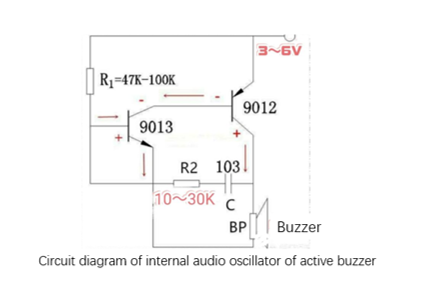
A manufacturing enterprise for all kinds of electroacoustic components
World-wide counseling service hotline
+86 519 81290886There are two types of buzzers: active buzzer and passive buzzer. The former has a built-in audio oscillator and does not need an external sound source when it is used. It can make sound as long as it is connected to the rated DC voltage, while the passive buzzer needs an external audio signal source when it is used. Because the structures of the two buzzers are different, the methods of detecting whether they are good or bad are also different, Here are their detection methods.
Detection of active buzzer

The audio oscillation circuit inside the active buzzer is generally composed of two SOT-23 encapsulated patch complementary triodes as shown in the above figure, The oscillation frequency is mainly determined by resistance R2 and capacitance C (also related to the power supply voltage). By changing its value, different oscillation frequencies can be obtained. BP is the buzzer coil. In other words, this active buzzer is actually a passive buzzer with an audio oscillation circuit integrated inside.
When the active buzzer with built-in sound source is used, the pin has polarity, the pin length is the positive pole, and generally a "+" sign is marked at the positive pin. When in use, the buzzer can emit a beep as long as it is connected to the rated DC voltage. Therefore, when detecting whether it is good or bad, it can not be used as long as it is connected to the appropriate DC voltage. If it cannot make a sound or the sound is very small. The common fault of the active buzzer is that the internal audio oscillation circuit is damaged due to the reverse polarity of the power supply or the high access voltage. The price of this active buzzer is very cheap. Generally, it is not necessary to repair it after damage. It can be replaced directly.
Detection of passive buzzer
The interior of the passive buzzer is just a coil, and the structure is similar to that of the headset. During operation, audio oscillation signals are connected at both ends of the coil, and the alternating magnetic force generated by the coil is used to drive the metal sheet on the internal magnet to produce mechanical vibration, so as to send out a buzzer. To judge the quality of this buzzer, you can directly measure the resistance between its two pins with the resistance gear of a multimeter. Under normal circumstances, this resistance is generally within 100 Ω. If the measured resistance is infinite, it indicates that the buzzer has been damaged. The common fault of this passive buzzer is that the pin is disconnected from the coil. In this case, it is generally replaced with a new one.

Independent brand (ISENSOR) products include: ultrasonic sensors, buzzers, speakers, etc., with more than 300 specifications and models
Contact us
